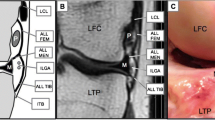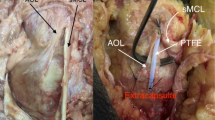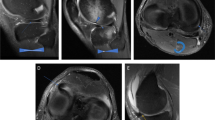Abstract
Objective
Lesions of the articular cartilage of the knee, especially early grades, are not always accurately detected by magnetic resonance imaging (MRI) because of contact between the articular cartilage surfaces of the femur and the tibia. This study aimed to assess the effects of axial leg traction during knee MRI examination on joint space widening and articular cartilage visualization and evaluate the ideal weight for traction.
Methods
MRI was performed on ten healthy volunteers using a 3-T MRI unit with a 3D dual-echo steady-state gradient-recalled echo sequence. Conventional MRI was performed first, followed by traction MRI. The traction weight increased in the order of 5 kg, 10 kg, and 15 kg. Joint space widths were measured, and articular cartilage visualization was assessed at the medial and lateral tibiofemoral joints. Volunteers were asked to evaluate pain and discomfort using a visual analog scale during each procedure with axial traction to assess the safety of traction MRI.
Results
The medial tibiofemoral joint space width significantly increased, and the visualization of the articular cartilage significantly improved by applying traction. The joint space width and the articular cartilage visualization showed no significant differences among traction weights of 5 kg, 10 kg, and 15 kg. Pain and discomfort during traction MRI examination were lowest with a traction weight of 5 kg.
Conclusion
Traction MRI examination may be useful in evaluating articular cartilage lesions at the medial tibiofemoral joint. A traction weight of 5 kg may be sufficient with minimum pain and discomfort.





Similar content being viewed by others
References
Phelan N, Rowland P, Galvin R, O’Byrne JM. A systematic review and meta-analysis of the diagnostic accuracy of MRI for suspected ACL and meniscal tears of the knee. Knee Surg Sports Traumatol Arthrosc. 2016;24(5):1525–39.
von Engelhardt LV, Kraft CN, Pennekamp PH, Schild HH, Schmitz A, von Falkenhausen M. The evaluation of articular cartilage lesions of the knee with a 3-Tesla magnet. Arthroscopy. 2007;23(5):496–502.
von Engelhardt LV, Lahner M, Klussmann A, et al. Arthroscopy vs. MRI for a detailed assessment of cartilage disease in osteoarthritis: diagnostic value of MRI in clinical practice. BMC Musculoskelet Disord. 2010;11:75.
Kohl S, Meier S, Ahmad SS, et al. Accuracy of cartilage-specific 3-Tesla 3D-DESS magnetic resonance imaging in the diagnosis of chondral lesions: comparison with knee arthroscopy. J Orthop Surg Res. 2015;10:191.
Evangelopoulos DS, Huesler M, Ahmad SS, et al. Mapping tibiofemoral gonarthrosis: an MRI analysis of non-traumatic knee cartilage defects. Br J Radiol. 2015;88(1052):20140542.
Gagliardi JA, Chung EM, Chandnani VP, et al. Detection and staging of chondromalacia patellae: relative efficacies of conventional MR imaging, MR arthrography, and CT arthrography. Am J Roentgenol. 1994;163(3):629–36.
Harman M, Ipeksoy U, Dogan A, Arslan H, Etlik O. MR arthrography in chondromalacia patellae diagnosis on a low-field open magnet system. Clin Imaging. 2003;27:194–9.
Lecouvet FE, Dorzée B, Dubuc JE, Vande Berg BC, Jamart J, Malghem J. Cartilage lesions of the glenohumeral joint: diagnostic effectiveness of multidetector spiral CT arthrography and comparison with arthroscopy. Eur Radiol. 2007;17(7):1763–71.
Simoni P, Leyder PP, Albert A, et al. Optimization of computed tomography (CT) arthrography of hip for the visualization of cartilage: an in vitro study. Skeletal Radiol. 2014;43(2):169–78.
Schmid MR, Pfirrmann CW, Hodler J, Vienne P, Zanetti M. Cartilage lesions in the ankle joint: comparison of MR arthrography and CT arthrography. Skeletal Radiol. 2003;32(5):259–65.
Omoumi P, Rubini A, Dubuc JE, Vande Berg BC, Lecouvet FE. Diagnostic performance of CT-arthrography and 1.5T MR-arthrography for the assessment of glenohumeral joint cartilage: a comparative study with arthroscopic correlation. Eur Radiol. 2015;25(4):961–9.
Mathieu L, Bouchard A, Marchaland JP, et al. Knee MR-arthrography in assessment of meniscal and chondral lesions. Orthop Traumatol Surg Res. 2009;95(1):40–7.
Palhais NS, Guntern D, Kagel A, Wettstein M, Mouhsine E, Theumann N. Direct magnetic resonance arthrography of the knee: utility of axial traction. Eur Radiol. 2009;19(9):2225–31.
Saupe N, Zanetti M, Pfirrmann CWA, Wels T, Schwenke C, Hodler J. Pain and other side effects after MR arthrography: prospective evaluation in 1085 patients. Radiology. 2009;250(3):830–8.
Newberg AH, Munn CS, Robbins AH. Complications of arthrography. Radiology. 1985;155(3):605–6.
Becce F, Richarme D, Omoumi P, et al. Direct MR arthrography of the shoulder under axial traction: feasibility study to evaluate the superior labrum-biceps tendon complex and articular cartilage. J Magn Reson Imaging. 2013;37(5):1228–33.
Cerny M, Marlois R, Theumann N, et al. 3-T direct MR arthrography of the wrist: value of finger trap distraction to assess intrinsic ligament and triangular fibrocartilage complex tears. Eur J Radiol. 2013;82(10):e582–9.
Fox MG, Petrey WB, Alford B, Huynh BH, Patrie JT, Anderson MW. Shoulder MR arthrography: intraarticular anesthetic reduces periprocedural pain and major motion artifacts but does not decrease imaging time. Radiology. 2012;262(2):576–83.
Bartko JJ. The intraclass correlation coefficient as a measure of reliability. Psychol Rep. 1966;19(1):3–11.
Landis JR, Koch GG. The measurement of observer agreement for categorical data. Biometrics. 1977;33(1):159–74.
Kohyama S, Tanaka T, Shimasaki K, et al. Effect of elbow MRI with axial traction on articular cartilage visibility—a feasibility study. Skeletal Radiol. 2020;49(10):1555–66.
Widuchowski W, Widuchowski J, Trzaska T. Articular cartilage defects: study of 25,124 knee arthroscopies. Knee. 2007;14(3):177–82.
Niemeyer P, Pestka JM, Erggelet C, Steinwachs M, Salzmann GM, Südkamp NP. Comparison of arthroscopic and open assessment of size and grade of cartilage defects of the knee. Arthroscopy. 2011;27(1):46–51.
Hiranaka T, Furumatsu T, Kamatsuki Y, et al. Posttraumatic cartilage degradation progresses following anterior cruciate ligament reconstruction: a second-look arthroscopic evaluation. J Orthop Sci. 2019;24(6):1058–63.
Cooke D, Scudamore A, Li J, Wyss U, Bryant T, Costigan P. Axial lower-limb alignment: comparison of knee geometry in normal volunteers and osteoarthritis patients. Osteoarthr Cartil. 1997;5(1):39–47.
Bellemans J, Colyn W, Vandenneucker H, Victor J. The Chitranjan Ranawat award: is neutral mechanical alignment normal for all patients? The concept of constitutional varus. Clin Orthop Relat Res. 2012;470(1):45–53.
Llopis E, Cerezal L, Kassarjian A, Higueras V, Fernandez E. Direct MR arthrography of the hip with leg traction: feasibility for assessing articular cartilage. Am J Roentgenol. 2008;190(4):1124–8.
Lavdas E, Vlychou M, Zaloni E, et al. Elimination of motion and pulsation artifacts using BLADE sequences in shoulder MR imaging. Skeletal Radiol. 2015;44(11):1619–26.
Nagatomo K, Yabuuchi H, Yamasaki Y, et al. Efficacy of periodically rotated overlapping parallel lines with enhanced reconstruction (PROPELLER) for shoulder magnetic resonance (MR) imaging. Eur J Radiol. 2016;85(10):1735–43.
Clauser CE, McConville JT, Young JW. Weight volume and center of mass of segments of the human body. AMRL Technical Report. Ohio: Wright Patterson Air Force Base; 1969.
Niitsu M, Ikeda K, Iiai Y. Slightly flexed knee position within a standard knee coil: MR delineation of the anterior cruciate ligament. Eur Radiol. 1998;8(1):113–5.
Funding
This study was funded by the Japan Orthopedics and Traumatology Research Foundation (grant number 384).
Japan Orthopaedics and Traumatology Foundation,384,Sho Kohyama
Author information
Authors and Affiliations
Corresponding author
Ethics declarations
Ethics approval and consent to participate
All procedures performed in studies involving human participants were in accordance with the ethical standards of the institutional and/or national research committee and with the 1964 Helsinki Declaration and its later amendments or comparable ethical standards. Informed consent was obtained from all individual participants included in the study.
Conflict of interest
The authors declare no competing interests.
Additional information
Publisher's note
Springer Nature remains neutral with regard to jurisdictional claims in published maps and institutional affiliations.
Rights and permissions
About this article
Cite this article
Kikuchi, N., Kohyama, S., Kanamori, A. et al. Improving visualization of the articular cartilage of the knee with magnetic resonance imaging under axial traction: a comparative study of different traction weights. Skeletal Radiol 51, 1483–1491 (2022). https://doi.org/10.1007/s00256-021-03971-w
Received:
Revised:
Accepted:
Published:
Issue Date:
DOI: https://doi.org/10.1007/s00256-021-03971-w




